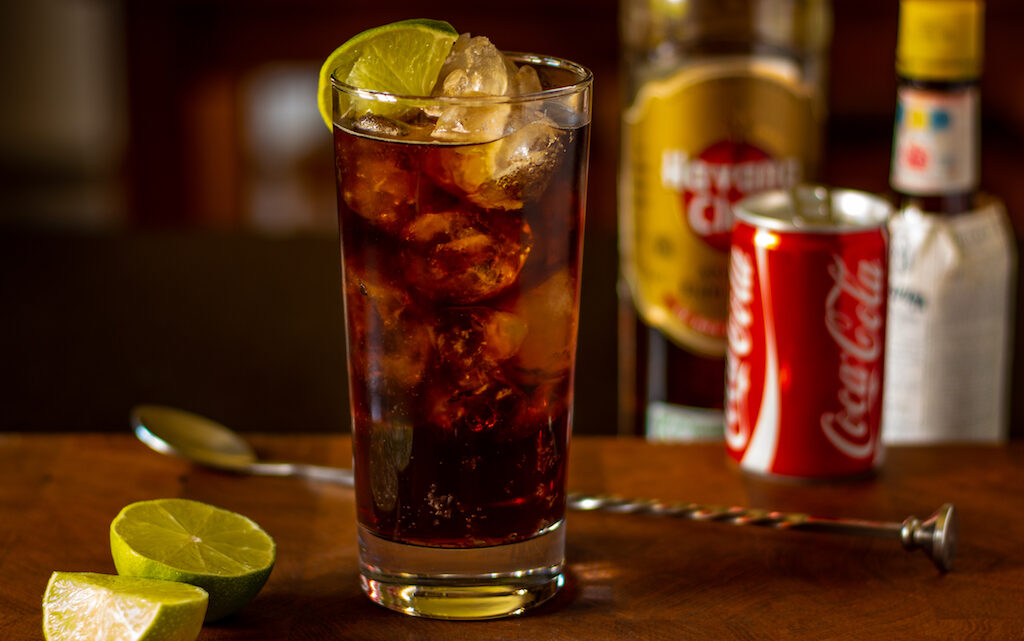Unmasking The Free Cuba: The True Story of a Legendary Cocktail

As a passionate and knowledgeable expert in the rum industry, I have always been fascinated by how a cocktail can encapsulate both the history and culture of a place. Among these legendary concoctions, the Free Cuba stands out as an icon, a symbol of revolution and cultural narratives that transcend time and borders.
This drink, more than a simple mix of rum, cola and lime, is a window into a world of stories and memories, a reflection of the complexity and spirit of an era.
My personal and professional interest in this cocktail is not accidental. Throughout my experience in the rum industry, I have developed a deep appreciation for drinks that tell a story, and the Cuba Libre, with its blend of simplicity and depth, has always captured my imagination.
Through this article, my goal is to guide you on a detailed and enriching journey, unraveling the history and evolution of the Cuba Libre. I will try to explain how this cocktail has not only survived but thrived through different eras and cultures, consolidating its position as an undisputed classic in the world of cocktails.
Please do not hesitate to send me comments and suggestions to help me enrich and improve this information.
Origins of Free Cuba
The origins of Free Cuba are inextricably linked to the history and culture of Cuba, navigating myths and truths in the ocean of its rich cocktail tradition. This iconic cocktail, with its simple yet powerful combination of rum, cola, and lemon, made its first appearance in the late 19th or early 20th century, amid the effervescent air of change and revolution that characterized Cuba at the time.
The exact origin of the Free Cuba cocktail is somewhat uncertain and surrounded by various legends and anecdotes, but the most accepted version is that it was born in Cuba during the Spanish-American War at the end of the 19th century, around 1898.
The cocktail is said to have been created by American soldiers who were in Cuba during the war. A soldier popularly associated with the creation of Free Cuba is Captain Russell, who, according to legend, mixed rum with cola and lemon, toasting “Por Cuba Libre!” in reference to a Cuba free of Spanish domination.
The exact place where Free Cuba was created is unclear, but it is very likely that it was in Havana, where American and Cuban soldiers mingled and celebrated their victory and hope for a free future for Cuba.
As for the ingredients, Coca-Cola was introduced to Cuba around the same time, and rum was already a popular drink on the island, which makes it plausible to create this cocktail in that historical and geographical context.
Rum in Free Cuba
Rum, the vibrant soul of Cuba Libre, has been a constant that has permeated every sip of this iconic cocktail with centuries of history and culture. This distillate is more than just an ingredient; it is a testament to the richness and diversity of Cuban and Caribbean tradition.
Provenance and Quality
The quality and origin of the rum used in Free Cuba play a fundamental role in the taste and authenticity of the cocktail. Traditionally, it is preferred to use a good quality Cuban rum to maintain its original character and robust flavor.
Evolution and Adaptability
Over the years, rum has evolved, and with it, Free Cuba. Different types of rum, from the lightest to the darkest and most robust, have found their way into variations of the cocktail, allowing for a rich exploration of flavours and styles.
Interaction with other Ingredients
The interaction of rum with cola and lemon in Free Cuba is not static. The rum brings sweetness and warmth, which is balanced with the acidity of the lemon and the carbonated sweetness of the cola, creating a refreshing and balanced drink.
Cultural impact
Rum in Free Cuba has not only influenced the cocktail’s structure and flavor, but also its cultural resonance. As an emblem of Cuban identity, rum has helped make Free Cuba a symbol of resistance, freedom, and national pride.
Rum remains an unbreakable pillar in the historical continuity of Free Cuba, ensuring that the cocktail not only endures but also evolves over time, adapting to new generations and tastes, but always maintaining its essence and connection with its Cuban roots.
The Cuban Revolution and Free Cuba
The Cuban Revolution was a cardinal event that not only transformed Cuba’s politics and society, but also left an indelible mark on cocktail culture, specifically in the history of Free Cuba. This cocktail, already imbued with symbolism of freedom and resistance, found new resonances in the context of the revolution.
Symbolism of Freedom
El Free Cuba, born in a time of change and struggle for independence, found an echo in the Cuban Revolution. Its name, meaning “Free Cuba,” resonated with revolutionary aspirations, symbolizing the ongoing struggle for freedom and autonomy.
Impact on the Rum Industry
The policies implemented during and after the revolution had a direct effect on the rum industry in Cuba. The nationalization of distilleries and the reconfiguration of rum production and distribution affected its quality and international reputation.
Changes in Global Perception
The revolution and subsequent political and economic tensions, including the US embargo, influenced how Free Cuba was perceived worldwide. In some contexts, the cocktail became a symbol of solidarity with Cuba, while in others, it was affected by global political dynamics.
Adaptability and Resilience
Despite political and economic challenges, Free Cuba has demonstrated remarkable resilience, adapting to changes and maintaining its popularity. Its simplicity and powerful symbolism have helped maintain its global relevance and appeal.
The interaction between politics, history and culture is evident in the trajectory of Free Cuba, demonstrating how a cocktail can be a reflection of the times and the tensions that surround it and maintaining its place in global culture as a drink of resistance, revolution and, above all, freedom.
Ingredients and Variations
Free Cuba has maintained its essence over time thanks to its simple but powerful recipe. Next, we’ll look at its classic ingredients and explore some modern variations that have emerged over the years.
Classic Ingredients:
Rum: Traditionally, Cuban rum is the spiritual basis of the cocktail, providing a distinctive soft and sweet character.
Coca-Cola: The effervescence and sweetness of Coca-Cola complement the rum, providing a pleasant carbonation.
Lemon: A touch of fresh lemon adds acidity and freshness, balancing the sweetness of the cocktail.
Modern Variations:
Rum Selection: There is a tendency to experiment with different types of rum, including aged rums or rums from different regions.
Other Soft Drinks: Some modern versions experiment with different types of soft drinks, altering the sweetness and carbonation.
Addition of Spices and Fruits: Ingredients such as mint, ginger or bitters can be added to create complexity and new flavours.
Presentation: Variations in presentation, such as different types of glasses and decorations, are also common to give a modern touch to the classic cocktail.
Global influence
– With globalization, the cocktail has been influenced by ingredients and techniques from different parts of the world, leading to a diversity of local interpretations of Free Cuba.
Free Cuba, despite its history and tradition, remains a canvas for innovation and creativity in the world of cocktails, allowing an infinite variety of expressions and adaptations that respect its legacy while exploring new horizons of flavor and presentation.
The Cultural Influence of Free Cuba
Free Cuba is not just a cocktail; it is a potent symbol imbued with history, resistance and culture. Its name and ingredients tell a story that goes beyond the mixture of rum, cola and lemon, leaving an indelible mark on popular culture. Next, the most notable aspects of this cultural influence will be examined:
Symbolism of Freedom and Resistance
The name “Cuba Libre” (Free Cuba), in itself, is a cry of freedom, reflecting the aspirations of a country in search of its independence and sovereignty.
Impact on Music and Art
The cocktail has been mentioned and celebrated in various art forms, including music and cinematography, where it is often used as a symbol of resistance, celebration, and Cuban culture.
Influence on Cocktails
As a cocktail classic, Free Cuba has influenced the creation and adaptation of other cocktails and has helped popularize rum as a versatile and appreciated spirit in mixology.
Representation of Cuban Culture
Free Cuba carries with it a wealth of Cuban history and culture, presenting itself as a window into the nation’s traditions, music, and struggles.
Globalization and Adaptation
Through globalization, Free Cuba has been adapted and reinterpreted globally, allowing a mix of cultural influences that have contributed to its perpetual relevance and popularity.
The Free Cuba, through its rich history and evolution, remains a cocktail that resonates with powerful echoes of resistance, freedom and culture, maintaining its place as an iconic drink and a significant cultural symbol in the contemporary world.
Preparing the Perfect Free Cuba
Creating the perfect Free Cuba requires more than just mixing the basic ingredients. Here are some tips and tricks to do justice to this historic cocktail and enhance its flavor and presentation:
Rum Selection
Choosing a quality rum is essential. A Cuban aged rum is traditional, but you can also experiment with different types of rum to find the one you prefer.
Use of fresh lemon
Use fresh lemon juice instead of bottled or concentrated juice. The freshness of the lemon will help to highlight the flavours of the cocktail.
Proportion of Ingredients
Maintain the right proportions of rum, cola, and lemon juice for a perfect balance of flavors.
Ice
Use fresh ice and make sure the glass is cold enough. Ice not only cools the drink, but also helps blend the flavors.
Coke
Opt for a good quality glue and make sure it is well carbonated. The coke adds sweetness and effervescence to the cocktail.
Angostura Bitters (optional but recommended)
A few drops of angostura bitters can add complexity and balance. It helps enhance the flavors and adds an aromatic dimension to the cocktail.
Presentation
Consider garnishing the glass with a slice of lemon or even a sprig of mint to enhance the presentation and add a fresh aroma.
Customization
Do not hesitate to adjust the proportions to adapt the cocktail to your personal taste. You can also experiment with additional ingredients or different mixing techniques.
Enjoy Responsibly
Make sure you enjoy yourFree Cuba responsibly. Remember, quality and the tasting experience are more important than quantity.
By following these tips, you can prepare a Free Cuba that not only respects its rich traditions and history, but also satisfies your palate.
Conclusion
Free Cuba is not just a cocktail; it is a vibrant symbol that encapsulates pivotal moments in history and culture. Her birth, woven into the tapestry of war and revolution, gives her a legacy deeply rooted in the struggle for freedom and independence. Over the years, it has evolved, adapting to the changing landscapes of cocktails and global preferences, but never losing its original essence and meaning.
Looking to the future, Free Cuba seems to maintain its relevance. Its simplicity, accessibility, and the powerful resonance of its name and origin continue to capture the imagination of those seeking both indulgence in a refreshing cocktail and a connection to a larger story. In a world that increasingly values authenticity and narrative, Free Cuba holds a special place, carrying the stories of its homeland and those who found hope and celebration in its unique blend.
Dedicated to uncle Alberto “Kinder” Quintero, who swam daily in Cuba Libres.
Sources
Featured image: The Nosey Chef
About The Author
Camilo is an audiovisual communicator with over 15 years of experience. He resides in Caracas, Venezuela, and has studied film and television, acquiring skills in writing film scripts. He currently works as a Digital Content Manager at TRL. If you would like to see his portfolio, you can visit his website at http://ccesarino.com.













